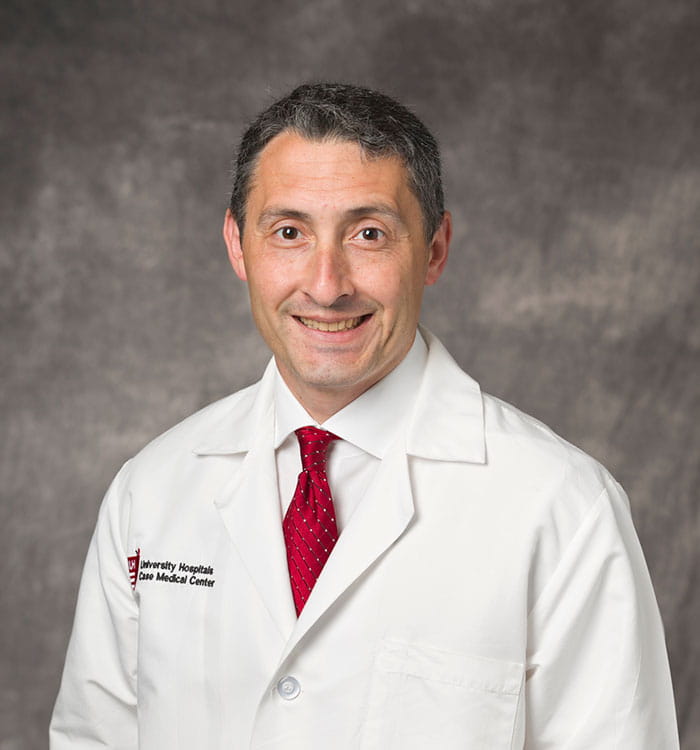UH Introduces Stealth Autoguide™ for Precision Neurosurgery
January 14, 2021
New robotic guidance platform reduces risk for patients undergoing complex brain surgery
Innovations in Neurology & Neurosurgery | Winter 2021
There is no room for error when operating on the brain.
 Andrew Sloan, MD
Andrew Sloan, MD Nicholas Bambakidis, MD
Nicholas Bambakidis, MD“Close doesn’t work in brain surgery,” says Andrew Sloan, MD, MBA, FACS, Director of the Brain Tumor and Neuro-Oncology Center and the Center for Translational Neuro-Oncology at University Hospitals Neurological Institute and University Hospitals Seidman Cancer Center and the Peter D. Crisal Chair of Neurosurgical Oncology, UH Cleveland Medical Center. Dr. Sloan is also Professor and Vice Chairman, Department of Neurosurgery, Case Western Reserve University School of Medicine. “That’s the difference between a successful surgery with a perfect patient outcome and a patient who is paralyzed and can’t walk or talk.”
As a cancer surgeon and brain surgeon at UH, Dr. Sloan primarily operates on tumors located inside the middle of the brain. Neurosurgeons can’t use endoscopic approaches in these cases, which means there is no camera to guide them to the correct target.
“A general surgeon can navigate with an imaging camera to get the right location and go in from different angles,” he explains. “With the brain, you have to find the exact entry point, target and trajectory, and execute the plan perfectly.”
In November, University Hospitals Cleveland Medical Center introduced a new tool to enhance precision in complex neurosurgery: Medtronic’s Stealth Autoguide™ platform. The medical device company selected UH as only the second Midwest site east of the Mississippi to use its new cranial robotic guidance platform, designed for adults and pediatric patients with neurological conditions.
The complete system includes a robot that provides stereotactic positioning and trajectory guidance, and a drill, which uses precise, almost imperceptible, movements to reach the surgical target. Surgeons can also access real-time navigation and visual feedback through a computer interface.
“Bringing technology like this to UH increases safety, shortens length of stay and reduces complications for our patients,” says Nicholas Bambakidis, MD, MD, FAHA, FAANS, Director of the UH Neurological Institute, and Professor of Neurological Surgery, Case Western Reserve University School of Medicine.
AN ‘ELEGANT TECHNOLOGY
When performing a brain biopsy or placing an electrode or catheter in the brain, UH neurosurgeons must not only find the right surgical target but also the safest way to reach it – navigating through a complex network of cells, wiring and fibers to reach a precise spot. “That’s what this technology does for us,” Dr. Sloan says.
In the past, they achieved this by making a manual incision in the patient’s skin and using a series of articulating robotic arms to hold the trajectory. With the robotic neurosurgery platform, Dr. Sloan can manually move the device to where it needs to enter and then the robot takes over, finding the correct angle of trajectory to drill, he says. That point is also fixed at the skull by the robotic mechanism.
“You can minimize movement during procedures and hit the trajectory you’re trying to target quicker the first time,” says Dr. Sloan, who was one of the first UH surgeons to use the Stealth Autoguide. “It’s an elegant, simple device that is extremely precise.”
Another notable feature is that the device allows for precise drilling of a coordinated surgical trajectory even in an oblique plane, which is especially critical in neurosurgery.
“Everyone's brain is as unique as a fingerprint, so the best trajectory is not always straight through at a perpendicular angle,” Dr. Sloan explains. “It may be a tangent of 20, 30 or 40 degrees, which makes the surgery more complex.”
So far, surgeons at UH Neurological Institute have performed 12 surgeries using the Stealth Autoguide, with more planned in 2021. The platform will be used primarily for biopsies of the brain, but also for patients who require deep brain stimulation, seizure monitoring and laser interstitial thermal therapy, a surgical technique to precisely target and treat metastatic brain tumors.
“University Hospitals is helping pioneer the field of laser interstitial thermal therapy, and even led the first human trial in 2007,” Dr. Sloan says. “We’re well-known as a high-quality program with very good outcomes, innovative techniques and technology.”
Dr. Bambakidis adds, “Being chosen to house the first iteration of robotic therapy for brain surgery is recognition of our leadership in the field and how we’re employing technology to improve patient care.”
In January, Dr. Sloan used the Stealth Autoguide to place a convection-enhanced delivery (CED) catheter, a technique that allows surgeons to administer medical therapies directly to a tumor site. UH Seidman Cancer Center is using CED catheters to treat glioblastoma patients with genetically modified poliovirus, which has been shown to jump-start a patient’s immune system to attack the cancer.
“Because you put a catheter into the tumor, it must be very precisely applied,” Dr. Sloan says. “Instead of trying to get the last quarter of a degree or millimeter down, with the robot, I can just press a button. The amount of precision is incredible.”
More precise, robotic neurosurgery has wide-ranging benefits for patients. Robotic-guided positioning and drilling eliminates the need to shave the patient’s head for the procedure or use a large stereotactic headframe. Added efficiency shortens the overall procedure time. And, most important, it reduces risk for patients who undergo complex brain procedures.
“The biggest risk is in the 10% or 15% of cases that are very complex,” Dr. Sloan says. “We want to take that risk down from 20% to 1%. That's what we're doing with this technology, and we're doing it every time.”


